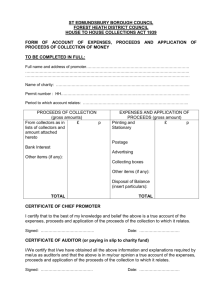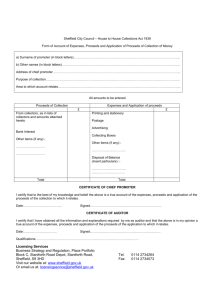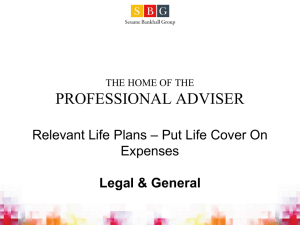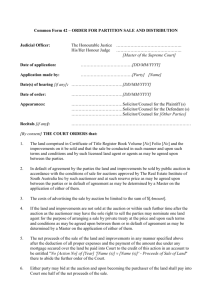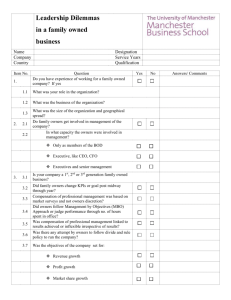Understanding business insurance
advertisement
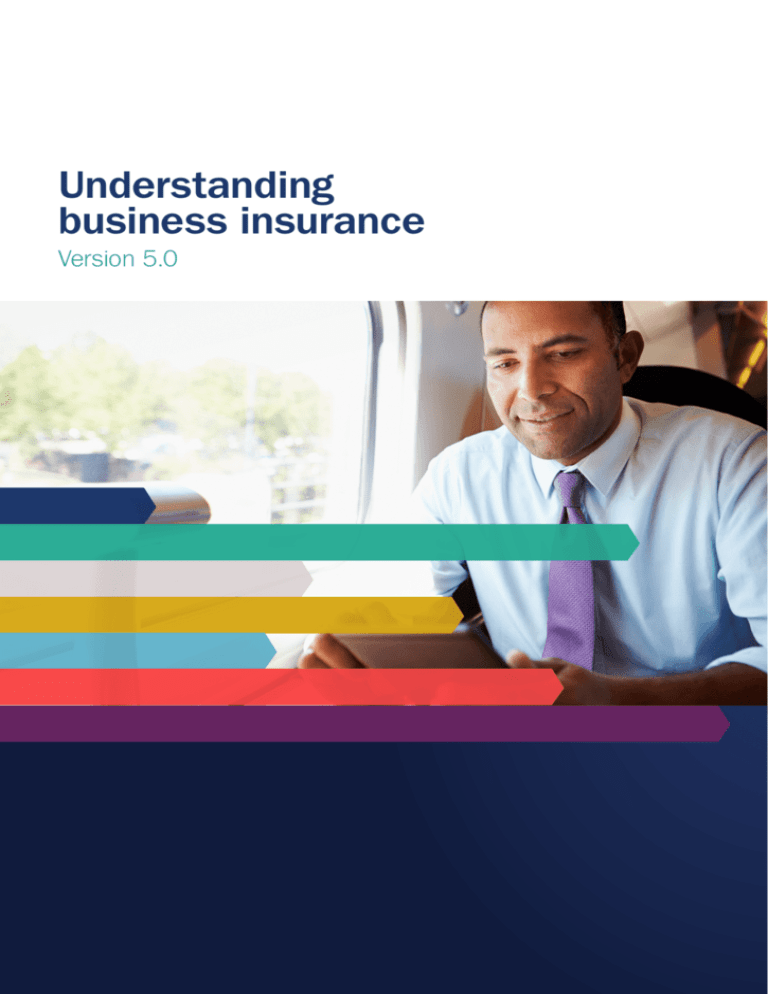
Understanding business insurance Version 5.0 This document provides some additional information to help you understand the financial planning concepts discussed in the SOA in relation to business insurance. This document has been published by GWM Adviser Services Limited AFSL 230692, registered address 105–153 Miller St North Sydney NSW 2060, ABN 96 002 071 749 for use in conjunction with Statements of Advice prepared by its authorised representatives and the representatives or authorised representatives of National Australia Bank Limited, Godfrey Pembroke Limited, Apogee Financial Planning Limited, Meritum Financial Planning Limited, JBWere Limited and Australian Financial Services Licensees with whom it has a commercial services agreement. This document contains general information about the benefits, costs and risks associated with certain product classes and strategies. It is designed for use in conjunction with a Statement of Advice that takes into account the circumstances and objectives of an individual. Before making a commitment to purchase or sell a financial product, you should ensure that you have obtained an individual Statement of Advice. As legislation may change, you should ensure you have the most recent version of this document. HOW TO READ THIS DOCUMENT Managing your finances to meet your day to day requirements as well as your long-term goals can be a complex task. There are all sorts of issues you need to consider such as taxation, legislation, protecting your wealth and assets, associated costs and the inherent risks of investment. When undertaking a financial plan, it is important you understand how these issues will impact you and what you should expect over time. Your financial adviser will provide you with a Statement of Advice (SOA) which sets out the details of the advice and how it will achieve your goals and objectives. This document provides some additional information to help you understand the financial planning concepts discussed in the SOA in relation to business insurance. It is very important you read this document to help you understand the benefits of the strategies recommended to you and the associated costs and risks. Please contact your adviser if you do not understand anything or need further information or clarification. Business insurance as part of a business succession plan Whether your business is structured through a partnership, company or trust, few have effective mechanisms in place for the transfer of equity and/or control if one of the owners is lost to the business due to death, disablement or a critical illness. In many cases the loss of a business owner from one of these events results in the demise of an otherwise healthy business simply because there was no succession plan and funding agreement in place. A business succession plan incorporating insurance funding protects your investment and ensures the survival of your business should one of the business owners or a key person die, become disabled or suffer a critical illness. Who is a key person? Most businesses have one or more key persons whose skill, knowledge, experience and leadership ensures the success of the business. A key person in any business may generally be defined as one whose death, disablement or early retirement may have an adverse economic effect on the business. It is important to identify these key people and to quantify the adverse affect that is likely to be suffered by the business in the event of death, disablement or illness. There are three basic protection needs that typically apply to businesses: • Asset Protection • Revenue Protection, and • Ownership Protection. Asset Protection The most important asset to a business is not the obvious physical assets but the key person or persons. In the event of a key person’s death or disablement, a business may be forced to sell assets to maintain cash flow – particularly if creditors press for payment or debtors hold back payment. Similarly, customers and suppliers may not feel confident in the trading capacity of the business and its credit rating could fall if lenders are not prepared to extend credit. Outstanding loans owed by the business to the owners (or their beneficiaries) may also be called up for immediate repayment. What is Asset Protection? Asset Protection can provide your business with enough cash to preserve its asset base so it can repay debts, free up cash flow and maintain its credit standing if a business owner or loan guarantor dies or becomes disabled. It can also release personal guarantees secured by the business owner’s assets (such as the family home). Tax treatment of insurance premiums and proceeds Asset Protection (or capital purpose debt protection) poses a complex set of taxation issues. In addition to the Capital Gain Tax (CGT) provisions that apply to all life and disability cover, the commercial debt forgiveness rules and the taxation of company profits as dividends must also be considered. Generally, whilst the CGT provisions and the taxation of company profits favour individual beneficial ownership of cover, the commercial debt forgiveness rules tend to favour ownership of cover by the debtor (often the business). Understanding business insruance | 3 The table below summarises the issues and consequences of the various provisions. Death cover – proceeds Beneficial / Policy ownership CGT on proceeds Continuing principals (lend proceeds to Company) Terminating principal or spouse (lend proceeds to company) CGT on proceeds Critical Illness cover – proceeds Other issues or consequences CGT on proceeds x Company may have additional taxable profits on winding up. No protection of benefit under Bankruptcy Act. x Commercial debt forgiveness may apply to affect the company’s income tax liability. x Business continues Business continues to owe monies to to owe monies to If continuing continuing principals. continuing principals. No protection of benefit principals are not related to under Bankruptcy Act. the life insured. x Business continues to owe monies to terminating principal’s spouse / estate. Company (debtor / borrower) Terminating principal (repays debt on behalf of company) Other issues or consequences Total and Permanent Disablement cover – proceeds x Company may have additional taxable profits on winding up. Commercial debt forgiveness may apply to affect the company’s income tax liability. Commercial debt forgiveness provisions While it is our understanding the original purpose of the commercial debt forgiveness provision was not to catch transactions such as those above, the definition of ‘forgiveness’ in the Income Tax Assessment Act 1997 states ‘a debt is forgiven if the debtor’s obligation to pay the debt is released or waived, or is otherwise extinguished’. This could include for example insurance benefits received by a guarantor or business principal that are then paid directly to a company’s lender or bank. Assuming the relevant provisions apply, the impact of the commercial debt forgiveness provisions is to apply the ‘net forgiven amount’: • to reduce revenue losses of the debtor in the years of income before the forgiveness year of income; 4 | Understanding business insurance x Business continues to owe monies to terminating principal or spouse. • then any balance remaining of the net forgiven amount is applied to reduce the deductible net capital losses of the debtor in respect of years of income before the forgiveness year of income; • then any balance remaining of the net forgiven amount is applied to reduce the deductible expenditure of the debtor in the years of income before the forgiveness year of income; • then any balance remaining of the net forgiven amount is applied to reduce the cost base of the assets of the debtor as the beginning of the forgiveness year of income. If there still remains a balance of the net forgiven amount at this point, it is disregarded. x If continuing principals are not related to the life insured. x Other issues or consequences Company may have additional taxable profits on winding up. Commercial debt forgiveness may apply to affect the company’s income tax liability. Business continues to owe monies to continuing principals. Business continues to owe monies to terminating principal or spouse. Issues for consideration by business principals Business principals must therefore balance: • their concerns to ensure their personal guarantees provided to lenders are released. • the need to ensure the business itself does not suffer adversely from the operation of the commercial debt forgiveness rules • their desire to ensure ties with the terminating principal and/or their family or estate are severed, and • the need to ensure the continuing principals and proprietors do not incur additional tax liabilities unnecessarily. As the priorities for various business principals will vary, Asset Protection ownership solutions for each business is also likely to vary. Revenue Protection A drop in revenue is often inevitable when a key person is no longer there. Losses may also result from demand that can’t be met while finding and training a suitable replacement, errors of judgement by a less experienced replacement or through the reduced morale of employees. If there isn’t a suitable replacement within the business, it may take substantial time and financial inducement to find and train a successor. What is Revenue Protection? Revenue Protection can provide your business with cash to compensate for the loss of revenue and costs of replacing a key employee or business owner should they die or become disabled. Tax treatment of insurance premiums and proceeds Policies which are taken up for the purpose of protecting revenue are tax deductible to the business and the proceeds on payment are assessable income. Deductibility of revenue protection premiums is contingent upon the purpose for cover and how the sum insured was calculated being clearly documented at the time the cover was taken out and at every review. It is therefore prudent for you to prepare minutes which explains the purpose of the policy (i.e. to protect revenue) and the treatment of premiums and proceeds. This is required for auditing and taxation purposes. Ownership Protection The death of a business owner can result in the demise of an otherwise successful business simply because of a lack of business succession planning. While business owners are alive they may negotiate a buy-out amongst themselves, for example on an owner’s retirement. But what if one of them dies? The remaining owners must now negotiate with the deceased owner’s legal representative, who may be more concerned about the needs of the estate than the needs of the business. Many business owners mistakenly believe this contingency has been catered for in the business’ constitutional documentation but often there is no buy-out provision or if there is, it’s often ineffectually drawn up and inadequately funded. Similar issues arise when an owner is disabled and cannot (or no longer wishes to) be involved in the business. What is Ownership Protection? Ownership Protection can provide the continuing owners or their nominees with sufficient cash for the transfer of the outgoing owner’s equity to the continuing owners should a business owner die, become disabled, or suffer a critical illness. Tax treatment of insurance premiums and proceeds The premiums payable on nonsuperannuation policies which are taken for the purpose of protecting ownership are considered as being nontax deductible to the business owners. The proceeds are tax-free when the beneficial owner of the policy is the life insured or a relative of the life insured. The premiums on policies owned by the business owners and paid for by the business will generally be tax deductible to the business but subject to Fringe Benefits Tax (FBT). This will lead to an increase in the effective cost of the insurance. The premiums on policies owned by the business owners’ superannuation funds are tax deductible to the trustee of the fund. This deduction is usually returned to the member’s account (being the business owner). Furthermore, the business owner may choose to arrange additional contributions be made to the superannuation fund which will generally either be tax deductible to their business entity or themselves. The proceeds of superannuation death benefits paid to most beneficiaries will be tax-free. However, benefits paid to certain beneficiaries – such as children who are financially independent – will attract some tax. Similarly Total Permanent Disability (TPD) benefits paid to business owners under age 60 as a lump sum will attract some tax. Where superannuation benefits paid to a member or their beneficiaries attract tax, the amount of insurance recommended can be grossed up, so a desired net amount will be paid. While the additional insurance means a higher premium, the deduction received by the business entity or business owner for paying the premium will mean the cost of insuring will generally be less than if the insurance was arranged outside superannuation. Understanding business insruance | 5 Protecting against Total and Temporary Disability (TTD) Income Protection and Business Expenses cover are complementary insurances which can provide a business owner with regular income to maintain their lifestyle and the regular fixed expenses of the business in the event of total and temporary disablement. An accident or illness usually means time off work, added stress and a potential decline in job performance. Add to this the uncertainty of a future income and you have a recipe for financial disaster. Income Protection and Business Expenses insurance can help prevent this. Income Protection Income Protection insurance (also known as Salary Continuance) is designed to provide a regular income in the event you are unable to work due to sickness or injury. Generally, Income Protection insurance provides a regular income during a period of disablement for up to a pre-determined and agreed benefit period. The benefit amount payable is up to 75% of your income. When reviewing the insurance needs of your business, it is important to ensure each owner is able to continue drawing an income in the event they are unable to work because of injury or illness. Tax treatment of insurance premiums and proceeds The premiums payable on Income Protection policies are generally tax deductible. Income Protection insurance purchased through a superannuation fund is tax deductible to the fund. If the business pays the premiums on your policy, this is a tax deductible expense of the business with no FBT incurred. 6 | Understanding business insurance If the Income Protection policy is owned by the business entity and the insured owns at least 25% equity in the business (as a guide), the premium is tax deductible to the business with proceeds paid from the business to the owner assessable in the owner’s hands. The insured is required to pay Pay As You Go (PAYG) tax on the benefit in the event of a claim – this will be withheld by the business where the policy is owned by the business. Buy Sell agreement Business Expenses insurance There are two main issues that need to be addressed when planning for business succession in your estate plan: A complement to Income Protection insurance is Business Expenses insurance. This type of cover ensures the portion of your business expenses for which you are responsible can be met should you be temporarily unable to work due to injury or illness. Business Expenses insurance generally reimburses you for certain regular business expenses such as rent, utilities, lease costs and depreciation. It is important to note not all expenses will be covered. This can help cover your fixed business costs and keep your business afloat while you are recuperating. Generally, this type of insurance can cover up to 100% of eligible expenses up to the chosen benefit amount. The maximum benefit payment is for one year’s expenses. The reason is if you are disabled for longer than one year, the business would be disposed of or restructured in some way. Tax treatment of insurance premiums and proceeds The premiums payable on Business Expenses policies are generally tax deductible with any proceeds being assessable. Arrangements should be in place so each business owner or their estate agree on the value of the business and: • can get the full value of their equity in the business at the time of their departure or death, or • helps facilitate the continuing business owners in financing a buy-out of that share of the business. • the legal transfer of control and ownership of the business, and • the way the transfer of the business will be funded. The above can be achieved via a Buy Sell agreement. A properly funded Buy Sell agreement can be thought of as estate planning for your business – think of the Buy Sell agreement as a ‘business Will’ and the Insurance proceeds as the assets of this Will. A Buy/Sell agreement has two key components: Transfer agreement The Transfer agreement is entered into by the principals of a business to provide for the transfer of business interests in certain defined events. The agreement – which can be a part of or separate to a broader Business Succession agreement can cover: • voluntary events (such as retirement of a principal) • involuntary, insurable events (such as death, TPD or critical illness of a proprietor), or • involuntary, non-insurable events (such as bankruptcy of a proprietor or death, TPD or critical illness of a proprietor when adequate cover cannot be obtained for them). The Transfer agreement is traditionally a mandatory contract for sale and purchase of the outgoing proprietor’s business interest (sale contract). More recently it provides the remaining proprietors with the right to acquire the business interests of an outgoing proprietor (call option). The outgoing proprietor (or their estate) has the right to sell the interests of the outgoing proprietor to the remaining proprietors (put option). Funding agreement The Funding agreement is critical to Buy Sell agreements because it obliges the proprietor to take out insurance cover for the contingency that each proprietor may die (or become disabled) during the existence of the business. The insurance policies provide the funding to support the ultimate transfer of the business interests when and if it occurs. Insurance is generally the most cost-effective funding mechanism for transfer of business interests arising from death, TPD or critical illness of a proprietor. Alternatives such as self-funding or borrowing may not be possible or are undesirable to the business owners. The funding agreement should outline alternative funding mechanisms to cater for: • succession events that cannot be insured • business proprietors that cannot be insured, and • situations where the insurance proceeds may not be adequate to compensate the exiting proprietor for the transfer of their interest in the business. Ownership of the insurance policy There are a number of options available with respect to the ownership of an insurance policy used to fund a Buy Sell agreement. Funding a Buy Sell agreement through self ownership or superannuation ownership of life insurance policies will offer you both flexibility in holding and managing the life insurance policy as well as significant practical and taxation advantages over cross ownership or business ownership of the policies. Some of the major considerations when determining ownership options have been outlined below: Insurance owner Other issues or consequences Other issues or consequences Self • Simple • Proceeds from Life, TPD and/or Critical Illness are generally paid tax free • Premium costs are likely to differ however compensation can be made via an altered salary package • Effectiveness is dependant on a correctly worded Buy/Sell agreement Cross • Simple • CGT liability may arise • Premium costs are likely to differ however compensation can be made via an altered salary package • In the event of a change of owners it may be difficult to change the insurance policy Business • Simple • A change of ownership of the business will not result in change of ownership of the insurance • CGT liability may arise Superannuation • A simple means of funding where new owners enter or existing owners leave the business • Premiums can be funded concessionally from your beforetax income • In many instances, proceeds from Life, TPD and/or Critical Illness are generally paid tax free • Benefits can be paid as a pension, lump sum or a combination • Premium costs are likely to differ however compensation can be made via an altered salary package • Uncertainty over the sole purpose test • Critical Illness cover will most likely be outside of Superannuation • Tax may be payable in certain circumstances • Effectiveness is dependant on a correctly worded Buy/Sell agreement Understanding business insruance | 7 Self ownership provides a simple means of funding where new owners enter or existing owners leave the business without affecting other owner’s entitlements to insurance policy proceeds and without giving rise to any unnecessary tax implications. Where life insurance policies are not self owned, a number of adverse issues may arise from a practical perspective as well as under the income tax laws. These issues are summarised below. • If a business owner were to suffer a TPD or a critical illness and the insurance policy covering those events is owned by the business or other business owners (business and cross-ownership respectively), a CGT liability may arise to the policy owner on its receipt of the policy proceeds. Where the insurance policy is self owned (and the policy owner is the original beneficial owner), no adverse tax consequences should arise upon receipt of the policy proceeds irrespective of whether the insurance policy covers death, TPD or Critical Illness or all of these. • If an owner dies and the life insurance policy proceeds are paid to persons who are not the original beneficial owners of the policy then those persons may be subject to CGT on the proceeds they receive if the policy owner has given other consideration in respect of the acquisition of their interest in the policy. These circumstances may arise for example, where a policy is originally self-owned and then assigned to the company or where the original owner nominates the business to receive the policy proceeds. In return, the business promised to enter into a Buy/Sell agreement and thereby undertake all obligations arising under that agreement. These issues will not arise where the beneficial ownership of the policy does not change. • Where an owner of a business retires or leaves the business and the policies are not self-owned, they will not have a readily portable insurance policy to take with them. If the policy over their life is owned by the business and is assigned to the principal when the principal leaves the business, the estate of the principal could possibly be subject to CGT on the policy proceeds when paid as a result of the death of the life insured. • Where a business entity is a company and is the beneficial owner of the insurance policy, the distribution of the policy proceeds will be taxed as a dividend, a deemed dividend, a fringe benefit or a form of taxable remuneration where the company distributes the money to the continuing shareholder (to fund a purchase of shares from an outgoing shareholder) or where the money is paid to the outgoing shareholder as part of a share buy-back. Note the payment of the Life, TPD and Critical Illness insurance premiums of a self-owned policy by the business constitutes an expense payment fringe benefit and gives rise to a FBT liability for the business where the policy is owned by an employee or an associate of an employee. Funding a Buy Sell agreement through superannuation ownership of life insurance policies offers similar flexibility and practical advantages to self ownership as well as significant taxation advantages over self-owned policies. Additionally, there are tax advantages and flexibility in terms of funding the premiums as they can be funded concessionally from your before-tax income or alternatively from the investment balance of your super fund (at times when there are cash flow issues). Furthermore there is usually flexibility in terms of how benefits can be paid – as a pension, lump sum or combination. Benefit taxes can apply in some circumstances, however. The premiums on policies owned by the business owners and paid for by the business will generally be tax deductible to the business, but subject to FBT. 8 | Understanding business insurance Utilising other professional services Your solicitor should advise how the business continuation plan should be structured. The transfer of funding agreements will affect your legal rights and accordingly these documents must be prepared by a solicitor. The solicitor should check the proposed policy ownership recommendation to ensure compatibility with the Buy Sell agreement. Furthermore, there are several types of Buy Sell agreements used in the market with considerable complexity involving the transfer of equity. Ensure your Buy Sell agreement is constructed in consultation with your accountant. Your accountant will usually provide valuation information and any taxation advice relevant to your business succession plan. For example there can be taxation, Goods and Services Tax (GST), CGT and stamp duty implications involved. Additionally your accountant may assist in providing the valuation (and basis of the valuation) of the business. Finally, your accountant together with your solicitor can assist in identifying: • the operating entities that should be included in the Buy Sell agreement • the entities or people that own the operating entities, and • the debts and equity in each of the entities. Understanding business insruance | 9 654111M1115
